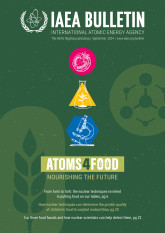By boosting crop yields on farmland, farmers can feed more people while avoiding deforestation, increased GHG emissions and depletion of the natural resources of soil and water. One solution is to use a stable isotope technique of nitrogen-15 to measure how plants take up nitrogen — one of the primary nutrients for optimal growth. This enables farmers to use smaller amounts of nitrogen fertilizer in a more targeted and efficient way, thereby reducing GHG emissions and increasing crop yields.
In a recent IAEA project, farmers in Burundi, the Central African Republic, Ghana, Nigeria, Rwanda, Zimbabwe and the Lao People’s Democratic Republic were able to double and triple their cassava yields by applying climate-smart agricultural practices.
“Everyone who visits my farm and sees the way I am farming and producing cassava — they get excited,” says Theogene Ntakarutimana, a farmer in Burundi who started growing cassava using methods enhanced with nuclear science and related techniques in 2016. “I used to have a low yield, about 11 tonnes per hectare, but thanks to the enhanced practices, production has increased to 30 tonnes per hectare, sometimes 33 tonnes.”
Through this project, farmers were trained in the use of nitrogen-15, a stable isotope of nitrogen, to measure cassava plant uptake of added nitrogen fertilizer and track the amount of nitrogen absorbed. They also received training in isotopic techniques to precisely determine the water required for cassava, and in pest management and soil improvement techniques.
Climate-smart agriculture involves monitoring soil moisture and offers solutions to address this challenge. Moisture sensors provide crucial information to farmers and help them to better manage their water consumption. In a recent project in Ethiopia, cosmic ray neutron sensors (CRNSs) were used to measure soil moisture. The sensors collect incoming cosmic rays and provide data that can be used by farmers. In Namibia, a country with unpredictable rainfall and episodes of severe drought, the IAEA has been able to help farmers apply precise drip irrigation techniques, increasing their water use efficiency by 80 per cent while continuing to increase crop yields.
IAEA technical cooperation projects are helping 146 countries address climate change adaptation through the application of nuclear techniques for plant breeding, animal production, food safety, health and insect pest control.









